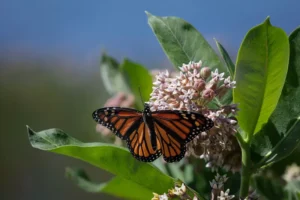Looking for Monarch Butterflies
Where my wife and I used to count twenty or more Monarch caterpillars per mile feeding on milkweed along the country road we live on, not so this year. This past summer the most we counted in a one mile stretch was three. Often there have been none. While disappointing, it’s not a huge surprise. Monarch numbers are crashing, dropping by 85% in just the last two decades according to The Center for Biological Diversity. There were around a billion of these delightful orange and black pollinators in 1996. Today the Eastern Monarch is considered endangered by the International Union of the Conservation of Nature. The U.S. Fish and Wildlife Service is slated to make their classification decision next year.
As a species, the Monarch Butterfly has been around for at least two million years. Today, thanks largely to us, their future is tenuous indeed unless we understand our role and make some changes.
The Monarch lays it’s eggs on milkweed only, and that’s also all the caterpillar feeds on. As our numbers have increased, so has our desire for the perfect, grassy lawn. Grass is in, milkweed is out. But the biggest culprit of all is our appetite for meat. To fatten the cattle and hogs we eat the Midwestern agricultural industry grows a lot of corn and soybeans for animal feed. The corn belt was once a richly diverse prairie habitat. That lost prairie is now an inhospitable mono culture. To get profitable yields of corn or soybeans farmers spray a lot of herbicides that kill milkweed as well as other plants. Where once Monarch moms found plenty of milkweed, today they find an empty nursery, and prime example of habitat loss. Add insecticides to the mix and you get an iconic butterfly teetering on the brink of extinction.
Humanity’s growing appetite for meat is also behind the agricultural attack on the Amazon rain forest. Similar to the destruction of the Midwestern prairie, Brazilian corn and soybean farms gnaw away at the fabric of the jungle, endangering it’s very existence. The enormous mass of the Amazon exhales moisture through it’s countless leaves creating its own climate, it’s own rain. As chunks are bitten out of the Amazon for farms the land near the edges begins to dry and the trees become vulnerable to increasing heat and drought. Where once the Amazon absorbed carbon from the air helping to keep greenhouse gasses in balance, today the increasingly fragmented forest is becoming just another tailpipe blowing carbon up into the atmosphere. Likely, this helps to explain why carbon emissions in our atmosphere are rising at record rates despite the world’s expanding use of renewable energy. Our worsening climate crisis adds yet another corner piece to the worldwide extinction puzzle. The Amazon rain forest is currently experiencing a terrible drought. Think about that.
What our way if life is doing to the Monarch Butterfly is only the tip of the extinction iceberg. The Audubon Society tells us that 389 birds species are on the brink of extinction in North America. That’s two thirds of our bird species, a quarter of all our State birds. According to the folks at the American Museum of Natural History a quarter of Earth’s mammals share that same fate.
Insects are the glue that holds Earth’s biosphere together. The web of life would fall apart without them on natures dinner table, and since they pollinate so many of the fruits and vegetables we depend on, that includes our own plates For the same reasons the Monarch Butterfly is tilting toward extinction, so are many in the insect world. Around the world numerous insect populations are declining so rapidly that without changes in our diet, the way we grow our food, and without drastically reducing – preferably eliminating – our use of pesticides the consequences for life on this planet by century’s end are dire indeed.
Back in the 1940’s when I was born we believed we had the luxury of making decisions about how to spend our money without a thought about the environmental impact. We were naive and we were wrong. The impact of more than tripling our world population since then makes the consequences of today’s eight billion decision makers clearer and clearer. The days of thoughtless consumption are over. As our climate becomes more and more dangerous, as our water, air and soils become more and more polluted and as more and more of the amazing life on this incredible planet go extinct, the responsibility for maintaining a livable planet falls squarely on our shoulders. If our children and grandchildren are to have lives worth living our choices must be educated ones, focused on protecting and nurturing a healthy ecosystem. We can add a system of environmental checks and balances into our decision making.
The future of our children is ours to shape. For starters we can garden, or buy healthy, fresh food at our local Farmers Market and CSA, instead of at the grocery chain that hawks what industrial agriculture is selling cheap to us – but at a devastating environmental price.
The good news, of course, is that we can turn this around. Perhaps Robin Wall Kimmerer in her excellent book Braiding Sweetgrass is right about trading in our Western market economy for the Indigenous gift economy. She writes: “In Western thinking, private property is understood as a “bundle of rights”, whereas in a gift economy property has a “bundle of responsibilities” attached. Our future, like the future of the Monarch Butterfly is in our hands today. It’s time we acted like that future matters, time we recognized what it means to live in good accord with Kimmerer’s “bundle of responsibilities”, and time to honor this planet and all her wonderful gifts with heartfelt gratitude and loving care.

